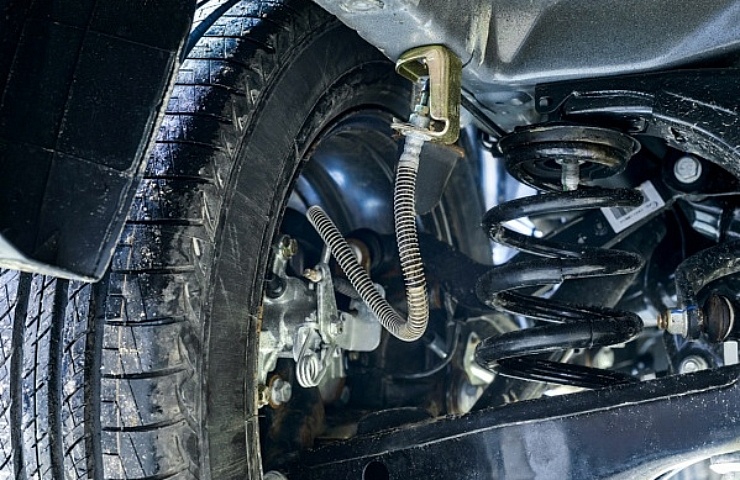Contents
You don’t need to be a professional mechanic to replace brake hoses on your vehicle. You only need basic expertise, a few standard tools, and the patience to learn.
Brake hoses and brake lines are terms that many people use interchangeably. But they are different parts of the car. Both transmit brake fluid, but they are made of different materials.
- A brake line is made of a rigid metal
- A brake hose is a flexible tubing made from a variety of materials
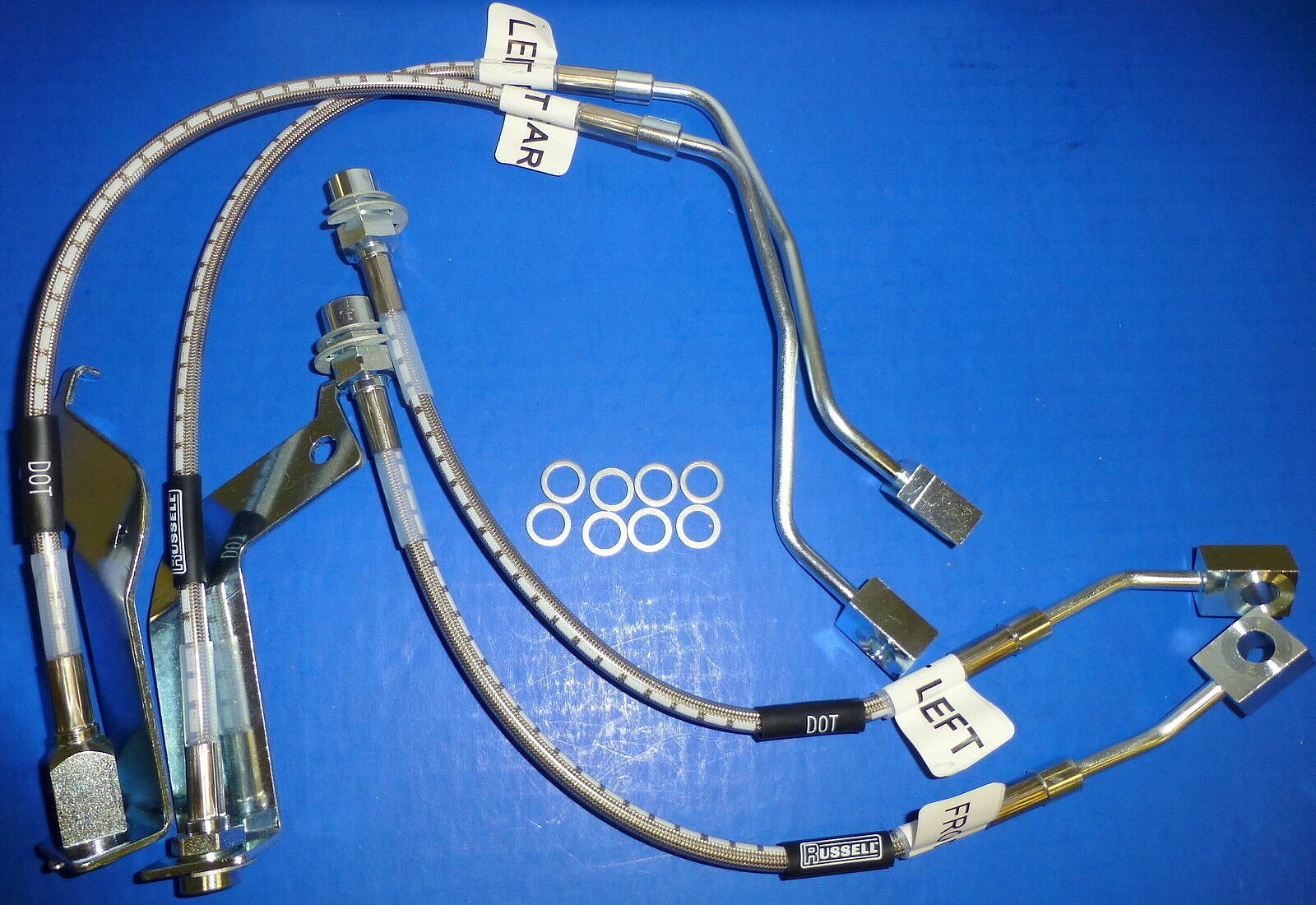
Russell stainless steel replacement brake hose kit for the 1999-2004 Ford Mustang
If you want to save money, learning the steps to replace brake hoses is easy. This guide explains the basics: what a brake hose does, how long it lasts, and what happens when it fails.
We also help you understand the replacement process and what it costs.
Shop now for brake hosesWhat Is a Brake Hose?
The brake line delivers fluid from the master cylinder to locations near the wheel. The line makes up most of how the fluid travels through the system. In comparison, the brake hose runs from the line to the brakes. It’s similar to the brake line, except it’s not rigid.

Rough Country Jeep Wrangler JK stainless steel brake hose kit
The rigid tubing would snap when you turn the wheels or go over a bump. So instead, flexible brake hoses, connected to the caliper on disc brakes, adjust with the wheel movements. In most cases, there is a separate flexible brake hose at each wheel.
Brake hoses can be made of the following materials:
- Rubber is the most common type, allowing for a cheaper cost
- Stainless steel is the more durable and long-lasting option, but it comes at a higher price
The type of hoses your car needs depends on the model and your budget. You can often upgrade the stock rubber hose to a stainless steel option if you want better performance.
How Long Does a Brake Hose Last?
A rubber brake hose has a typical lifespan of five to 10 years. Stainless steel braided hoses will last longer under the same conditions. Yet, there’s no way to determine the actual life of a brake hose because it depends on these factors:
- Weather in your area
- Where you park (in a garage or on the street)
- Conditions where you drive
Therefore, it’s best to inspect the brake hoses at least every six months to a year. You should also inspect the hoses if you notice any trouble braking. It’s good practice to perform a thorough brake inspection every time the wheels come off the car, so consider it part of your tire rotation checklist conducted every 5,000 miles or so.
How Do You Replace the Brake Hose?
Changing a brake hose is relatively simple, similar to changing your brake pads. You don’t need to be a professional mechanic.
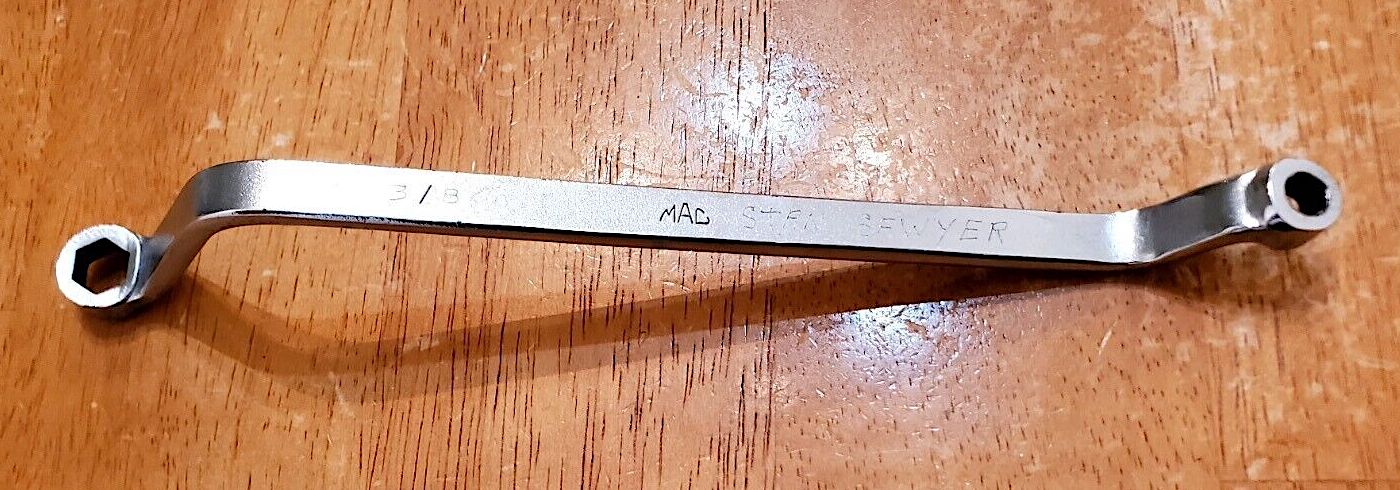
MAC brake bleeder wrench
Gather your gear: We recommend having the following tools and supplies.
- Brake fluid
- Brake fluid bleeder
- Drain pan
- Floor jack
- Hammer
- Jack stands
- Line wrench (to remove the connection to your caliper)
- Penetrating oil
- Pliers
- Safety equipment, such as glasses, gloves, and protective clothing
- Wrench (to use on the bleeder valve)
- Once you gather the supplies, you can move on to the following steps.
Remove the Wheel: Park the car on a level surface. Then, jack it up and secure it on jack stands. Remove the wheel where you are working. With the wheel off, put a drain pan below the hose to catch the mess.
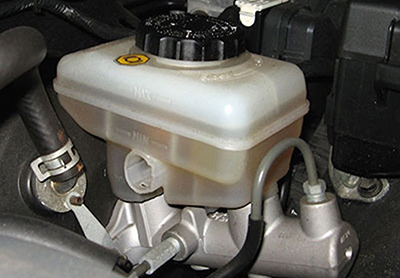
The master cylinder reservoir holds your vehicle’s brake fluid.
Check the Brake Fluid: Make sure the master cylinder has plenty of fluid in it. Once you begin to remove the hose, fluid will leak. If the master cylinder runs out of fluid, you will have more difficulty bleeding the system. Also, ensure the cap remains on the master cylinder throughout the process. Air in the brakes is dangerous, so these steps are critical.
Crack Open the Connections: With your line wrench, carefully open up the top connection. Leave it slightly attached until you take the hose out. It helps to also crack the connection to the brake caliper. However, don’t unscrew it completely. You want it to be easier to remove.
Shop now for brake hosesUse some penetrating oil if either of these connections is rusty or dirty. This oil makes removing connections easier.
Remove the Old Brake Hose: Now you are ready to take off the old hose. Start by removing the mounting bracket clip. If you damage or bend it, you must replace this part, so be careful. Unscrew the top connection: Take off the connection from the mounting bracket. Brake fluid will start coming out, so catch it in the pan. Unscrew the hose from the caliper. While the hose rotates, fluid can spray, so watch out.
Install the New Brake Hose: Hopefully, you have your new brake hose ready for a quick installation. Screw it into the caliper, but don’t damage the threads. Reseat the top connection back into the bracket. Wait to clip it back in. Tighten the nut. Use your hammer to tap in the mounting clips. Just don’t swing too hard, or you can damage the lines.
Secure the Hose: Now it’s time to tighten everything back up again. Again, ensure the connections are snug. Additionally, use a rag to clean up any mess that was made. Brake fluid damages car parts, so clean it off the paint and any rubber.
Bleed the Brakes: 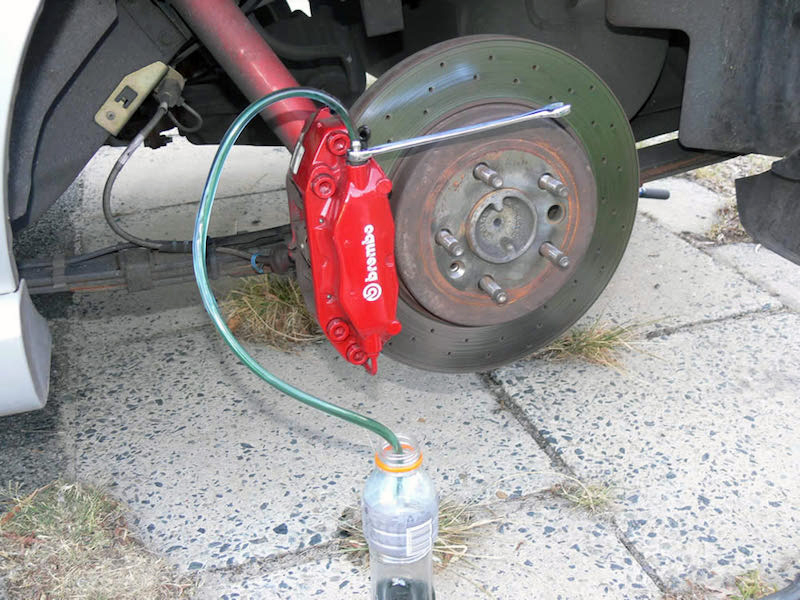
Once done, you can put the wheel back on and lower your car to the ground. Then, take the vehicle for a test drive to ensure the brakes work as expected.
What Are the Signs of a Faulty Brake Hose?
You’ll be able to tell when there’s trouble with a brake hose because of these symptoms:
- Soft brake pedal: When the pedal gets mushy or soft, you want to have the hoses checked.
- Physical damage: If you see cracks or wear to the hose, it’s time to replace it.
- Inoperable brakes: If you don’t catch the brake hose damage soon enough or it fails completely, the brakes become inoperable.
Thankfully, it’s rare to have the brakes entirely fail if you watch for other warning signs and take prompt action.
You may be able to continue driving with a leaking brake hose, but we don’t recommend it. As fluid leaks out of the hose, the system becomes compromised. Once there’s not enough fluid or pressure, the brakes will stop working. It’s not worth putting you or your passengers at risk. Replace the brake hose immediately.
How Much Does it Cost to Replace a Brake Hose?

StopTech Ford Fiesta ST stainless steel brake hose kit
Brake hoses can cost anywhere from $5 to more than $100, depending on the type of hose.
You will spend less on a simple rubber hose replacement. If you do this, remember to choose from a reputable brand. You may need to spend a little more, but it’s worth the cost. You may also prefer to buy OEM vs. aftermarket brake hoses, which are more expensive.
The cost can jump if you upgrade to stainless steel braided hoses. However, the performance of this material and its durability is superior.
Finally, check all the components associated with the replacement. For example, if you need new washers or fittings, now is the time to install them.
Shop now for brake hoses
